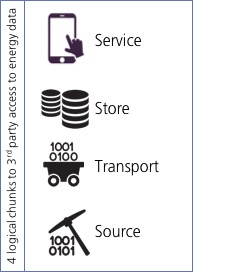For those that follow my posts, you will know I bang on a lot about utilities focusing services on consumer needs and desires. In an earlier post, I referred to this as designing from the outside in.
This principle of designing from the outside in applies to using third-party access to energy data to create a consumer-focused solution.
Rather than make this more complex than it needs to be, we can consider these solutions to be made up of logical chunks. When I think about third-party access to energy data, the four ‘chunks’ that come to mind are:
Services. These are the services organisations are going to offer consumers. A consumer will take up a service if it solves a problem, is from a source they trust and is via an engagement channel preferable to them. This ‘chunk’ is the most important as it’s all about creating services consumers want.
Storage. This ‘chunk’ is worried about making sure the data is securely received and stored. Discussions need to be had around making sure the data is accurate, is accessed by the right parties, and has all activity logged.
Transport. In this ‘chunk’ you are securely moving data from point A where data is sourced, to point B where data is stored. The focus here is making sure the right data is securely transported in a way that no-one can dispute the transaction.
Source. In this, we look at capturing the raw data from smart meters and other sensors. The focus needs to be on ensuring the right data is collected, at the right time, and is in the agreed format ready to be transported.
Over the coming weeks I’ll write in more detail about each ‘chunk’ and provide my thoughts as to how, here in Australia, we should consider their implementation.
When thinking about designing third party access to energy data, are there any other ‘chunks’ you would include?
To keep up-to-date with my latest articles, subscribe to my blog in the footer below.
My best-selling book, ‘The Digital Utility’, is available for purchase here.
